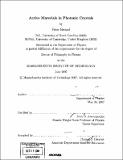Active materials in photonic crystals
Author(s)
Bermel, Peter (Peter A.)
DownloadFull printable version (48.38Mb)
Other Contributors
Massachusetts Institute of Technology. Dept. of Physics.
Advisor
John D. Joannopoulos.
Terms of use
Metadata
Show full item recordAbstract
I analyze new phenomena arising from embedding active materials inside of photonic crystal structures. These structures strongly modify the photonic local density of states (LDOS), leading to quantitative and qualitative changes in the behavior of active materials. First, I show that the emission spectrum of point-like sources inside an "omniguide" is strongly modified by features resembling one-dimensional van Hove singularities in the LDOS. The resulting overall enhancement of the LDOS causes radiating dipoles to emit more rapidly than in vacuum (known as the Purcell effect). Second, I study optically pumped lasing in three model systems: a Fabry-Perot cavity, a line of defects in a two-dimensional square lattice of rods, and a cylindrical photonic crystal. It is shown that high conversion efficiency can be achieved for large regions of active material in the cavity, as well as for a single fluorescent atom in a hollow-core cylindrical photonic crystal, suggesting designs for ultra-low-threshold lasers and ultra-sensitive biological sensors. Third, I consider a photonic crystal-based light-trapping scheme, capable of compensating for weak optical absorption of crystalline silicon solar cells in the near infrared. For a 2 pm-thick cell, relative efficiency enhancements as high as 35% are expected. Fourth, I explore a way to achieve full ±900 electronically-controlled beam steering using a linear array of one dimensionally periodic elements containing electro-optic materials. Fifth, I consider switching of a single signal photon by a single gating photon of a different frequency, via a cross-phase modulation generated by electromagnetically-induced transparency atoms embedded in photonic crystals. The exact solution shows that the strong coupling regime is required for lossless two-photon quantum entanglement. (cont.) Finally, I demonstrate that the Purcell effect can be used to tailor the effective Kerr nonlinear optical susceptibility. Using this effect for frequencies close to an atomic resonance can substantially influence the resultant Kerr nonlinearity for light of all (even highly detuned) frequencies. For example, in realistic physical systems, enhancement of the Kerr coefficient by one to two orders of magnitude could be achieved.
Description
Thesis (Ph. D.)--Massachusetts Institute of Technology, Dept. of Physics, 2007. Includes bibliographical references (leaves 129-139).
Date issued
2007Department
Massachusetts Institute of Technology. Department of PhysicsPublisher
Massachusetts Institute of Technology
Keywords
Physics.